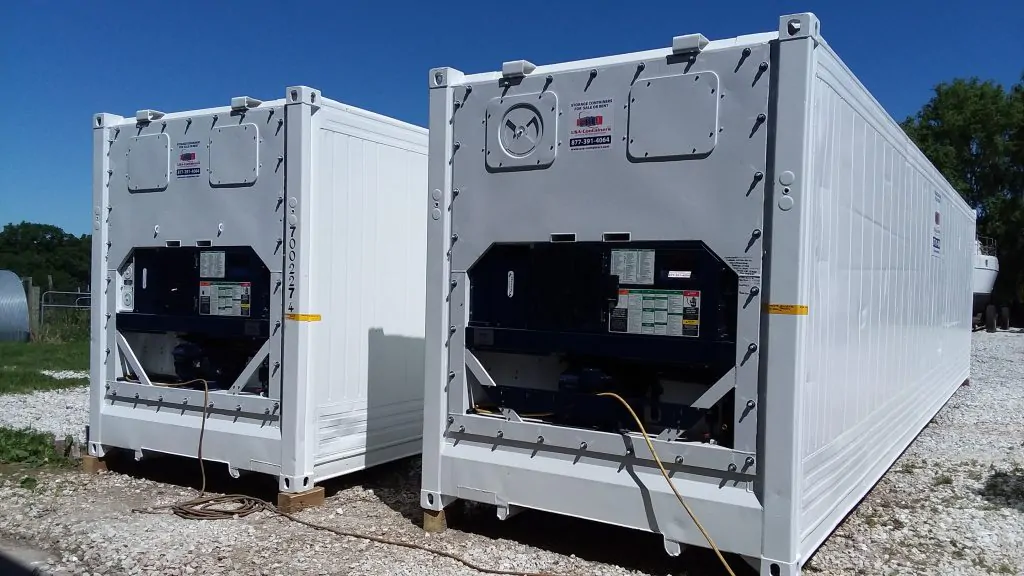Refrigerated shipping containers, often referred to as “reefers,” play a crucial role in the global supply chain by transporting perishable goods over long distances. These specialized containers are designed to maintain a specific temperature range, ensuring that products like food, pharmaceuticals, and chemicals remain fresh and safe during transit.
Understanding how refrigerated shipping containers work provides insight into the technology and processes that keep perishable goods in optimal condition, from the point of origin to their final destination.
1. Basic Structure of a Refrigerated Shipping Container
A refrigerated shipping container is similar in size and shape to a standard shipping container but is equipped with an integrated refrigeration unit. The container’s construction includes insulated walls, floors, and ceilings, which help to maintain a consistent internal temperature and protect the contents from external temperature fluctuations.
- Insulation: The walls, floor, and ceiling of a reefer are lined with polyurethane foam insulation, which minimizes heat transfer between the inside and outside of the container. This insulation is crucial for maintaining a stable temperature within the container, regardless of the external environment.
- Refrigeration Unit: The refrigeration unit is the heart of a reefer container. It is typically located at one end of the container and consists of a compressor, condenser, evaporator, and a thermostat. The unit is powered either by an external electrical supply, such as a ship’s power system, or by a diesel generator when in transit on trucks or trains.
2. Refrigeration Process
The refrigeration process in a reefer container operates on the same principles as a household refrigerator but on a much larger scale. The process involves the following steps:
- Cooling the Air: The refrigeration unit circulates refrigerant through a closed-loop system. The refrigerant absorbs heat from the air inside the container as it passes through the evaporator coils, effectively lowering the air temperature. The cooled air is then circulated throughout the container to maintain a consistent temperature.
- Heat Removal: The heated refrigerant is compressed and passed through the condenser, where it releases the absorbed heat to the outside environment. The refrigerant then cools down and returns to its liquid state, ready to absorb more heat as it cycles through the system again.
- Temperature Control: The thermostat inside the container monitors the internal temperature and adjusts the operation of the refrigeration unit to maintain the desired temperature range. This precise control ensures that the goods inside the container remain at the correct temperature, whether it’s freezing temperatures for ice cream or just above freezing for fresh produce.
3. Temperature Settings and Monitoring
Refrigerated shipping containers are capable of maintaining a wide range of temperatures, typically between -30°C to +30°C (-22°F to +86°F). This flexibility allows reefers to transport various types of perishable goods, from frozen meat to fresh vegetables.
- Pre-Trip Inspection (PTI): Before a reefer container is loaded, it undergoes a pre-trip inspection to ensure the refrigeration unit is functioning correctly. The container is pre-cooled to the required temperature to stabilize the internal environment before the goods are loaded.
- Temperature Monitoring: Modern reefers are equipped with advanced monitoring systems that allow real-time tracking of the internal temperature. These systems can send alerts if the temperature deviates from the set range, enabling immediate corrective action. This monitoring is crucial for maintaining the quality and safety of perishable goods during transit.
4. Airflow and Humidity Control
In addition to temperature, maintaining proper airflow and humidity levels is essential for preserving the quality of perishable goods.
- Air Circulation: Reefer containers are designed with built-in ventilation systems that ensure even air circulation throughout the container. This circulation prevents hotspots and ensures that all areas of the container maintain a consistent temperature.
- Humidity Control: Some reefer containers are equipped with humidity control systems, which are particularly important for goods like fresh produce that require a specific level of moisture to remain fresh. By controlling humidity levels, these containers can prevent products from drying out or becoming overly moist, both of which can lead to spoilage.
5. Power Supply Options
Refrigerated shipping containers require a continuous power supply to maintain their internal temperature. There are several options for powering reefers during transit:
- Shore Power: When stationary at a port or terminal, reefers can be plugged into the local power grid, known as shore power. This connection provides a stable power source for the refrigeration unit.
- Diesel Generators: During transportation by truck or train, reefers are often powered by diesel generators, which provide the necessary electricity to keep the refrigeration unit running. Some containers are equipped with their own generators, while others rely on external generator units attached to the vehicle.
- Ship Power: Onboard ships, reefers are typically connected to the ship’s power supply, ensuring they remain operational throughout the journey. Large container ships are equipped with power points to accommodate multiple reefers at once.
The Crucial Role of Refrigerated Shipping Containers
Refrigerated shipping containers are vital to the global logistics industry, enabling the safe and efficient transportation of perishable goods across vast distances. Their advanced refrigeration systems, combined with precise temperature control, airflow management, and reliable power supply, ensure that products remain fresh and in optimal condition from origin to destination.
Understanding how these containers work highlights the importance of technology in maintaining the integrity of the global supply chain, particularly for industries that rely on the timely delivery of perishable goods.
Keep an eye for more latest news & updates on Buzz Slash!




